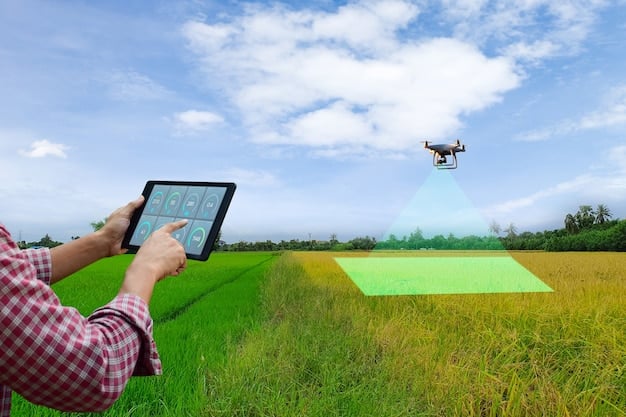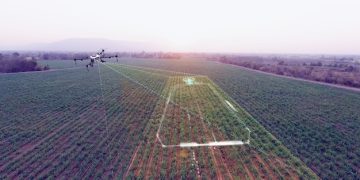Boosting Soil Health for Sustainable US Agriculture

Advertisements
Enhancing soil health in the US is crucial for sustainable agriculture, improving crop yields, reducing environmental impact, and ensuring long-term food security by focusing on biological, chemical, and physical soil properties.
Advertisements
In the vast expanse of the United States, from the fertile plains of the Midwest to the rich valleys of California, the health of our soil is not just a scientific interest, but the fundamental backbone of sustainable agriculture. Addressing The Science of Soil Health: How Can We Improve Soil Quality and Promote Sustainable Agriculture in the US? becomes a pivotal conversation, dictating the future of our food systems, environmental resilience, and even economic stability within rural communities. This exploration delves into the intricate biology, chemistry, and physics beneath our feet, uncovering strategies that promise to revitalize this indispensable natural resource for generations to come.
Advertisements
Understanding the Foundation: What is Soil Health?
Defining soil health is more complex than simply categorizing it as “good” or “bad”; it encompasses a dynamic set of properties that enable soil to function as a vital living ecosystem. Healthy soil supports plant and animal life, regulates water flow, filters pollutants, and cycles nutrients, all while maintaining its structure against erosion. It’s a holistic concept, stretching beyond mere fertility to include biological diversity and physical resilience. Understanding these interconnected components is the first step toward effective management and improvement. The focus must be on cultivating a living soil that can perform its myriad functions efficiently and sustainably over time.
The Biological Component: A Living Ecosystem Beneath Our Feet
The biological aspect of soil health is perhaps the most dynamic and often overlooked. Millions of microorganisms—bacteria, fungi, protozoa, and nematodes—work tirelessly to break down organic matter, cycle nutrients, and form stable soil aggregates. Earthworms and other macro-invertebrates burrow through the soil, creating channels for air and water, and mixing organic materials. This intricate web of life is essential for nutrient availability, disease suppression, and overall soil structure.
- Microbial Diversity: A wide range of bacteria and fungi ensures efficient decomposition and nutrient cycling.
- Earthworm Activity: Enhances aeration, water infiltration, and mixes organic matter throughout the soil profile.
- Root Symbiosis: Mycorrhizal fungi form symbiotic relationships with plant roots, extending their reach for water and nutrients.
- Organic Matter Decomposition: Microbes convert plant residues into humus, a stable form of organic matter.
Chemical and Physical Properties: The Supporting Framework
Beyond biology, the chemical and physical properties of soil provide the essential framework. Chemical properties like pH, nutrient availability (nitrogen, phosphorus, potassium, micronutrients), and cation exchange capacity determine the soil’s ability to hold and supply nutrients to plants. Physical properties, such as texture (sand, silt, clay content), structure, bulk density, and water infiltration rates, influence root growth, water retention, and aeration. These factors are interdependent, where improvements in one often positively impact the others, creating a virtuous cycle for soil health. Maintaining a balanced pH is crucial for nutrient uptake, as too acidic or alkaline conditions can lock up essential elements.
Current State of Soil Health in the US
The state of soil health across the United States presents a varied and often challenging picture. Decades of conventional agricultural practices, including intensive tillage, monocropping, and heavy reliance on synthetic fertilizers and pesticides, have contributed to significant degradation. Soil erosion remains a pervasive problem, with topsoil loss impacting productivity and water quality. Reduced organic matter content has diminished the soil’s capacity to retain water, store carbon, and support diverse microbial life. These issues are not confined to specific regions but are widespread, affecting the long-term viability of agricultural lands and the broader ecosystem. Recognizing these challenges is vital for developing targeted and effective solutions that integrate scientific understanding with practical implementation.
Studies indicate that a substantial portion of agricultural land in the US suffers from some degree of degradation, manifesting as decreased fertility, compaction, and loss of biodiversity. The consequences extend beyond the farm gate, influencing water quality in rivers and lakes through nutrient runoff and sedimentation, and contributing to atmospheric carbon emissions. Furthermore, the diminished resilience of degraded soils makes them more vulnerable to extreme weather events, such as droughts and floods, exacerbating agricultural losses and increasing the risk of food insecurity. Addressing these pervasive issues requires a concerted effort to shift towards more regenerative practices.

Impact of Conventional Practices
Conventional farming methods, while initially boosting yields, often neglect the long-term health of the soil. Tillage, for instance, disrupts soil structure, leading to compaction and the loss of organic matter. It also exposes soil to wind and water, increasing erosion. The continuous use of synthetic fertilizers can alter the delicate balance of soil microbes, and pesticides can harm beneficial organisms. Monocropping depletes specific nutrients and reduces microbial diversity, making soils more susceptible to pests and diseases, thus perpetuating a cycle of increased chemical reliance. This cycle often results in reduced water infiltration and increased runoff, further degrading the soil and impacting surrounding ecosystems.
- Tillage: Disrupts soil aggregates, leading to organic matter oxidation and increased erosion.
- Synthetic Fertilizers: Can harm beneficial microbial populations, reducing nutrient cycling efficiency.
- Pesticides: May kill non-target organisms, including beneficial insects and soil microbes critical for decomposition.
- Monocropping: Leads to nutrient depletion and reduced biodiversity, increasing susceptibility to pests.
Regional Variations in Soil Health Challenges
The challenges to soil health vary significantly across the diverse geographical and climatic regions of the US. In the Corn Belt, historically productive soils face issues of compaction and nutrient runoff due to intensive corn and soybean rotations. In arid Western states, water scarcity, salinization, and wind erosion are primary concerns. Southeastern soils often grapple with low organic matter content and acidity. Each region requires a tailored approach to soil health improvement, considering local ecological conditions, crop types, and farming systems. Understanding these regional distinctions allows for the development and adoption of context-specific solutions, maximizing their effectiveness.
Key Strategies for Improving Soil Quality
Improving soil quality is a multifaceted endeavor that requires a shift towards practices that mimic natural ecosystems. The core principle revolves around minimizing disturbance, maximizing biological diversity, keeping the soil covered, and ensuring a continuous living root system. These strategies work synergistically to build organic matter, enhance soil structure, improve water retention, and foster a thriving microbial community. Farmers and land managers have a diverse toolkit of practices at their disposal, each contributing to the holistic health of the soil. The adoption of these strategies not only benefits the soil but also yields significant environmental and economic advantages.
The goal is to move from exploitative practices to regenerative ones, fostering a symbiotic relationship between agriculture and the environment. This paradigm shift requires an investment in education, research, and incentive programs to support farmers in transitioning to more sustainable methods. Long-term planning, coupled with adaptive management, is essential to address the complex and dynamic nature of soil ecosystems. By prioritizing soil health, we can ensure the productivity and resilience of agricultural lands for future generations, while simultaneously mitigating climate change and protecting biodiversity. This proactive approach benefits both the agricultural community and the broader society.
No-Till and Reduced Tillage Farming
Minimizing soil disturbance through no-till or reduced tillage practices is one of the most impactful strategies for improving soil health. By foregoing plowing and extensive cultivation, farmers protect soil structure, reduce erosion, and prevent the loss of organic matter. This allows for the development of stable soil aggregates, enhances water infiltration, and creates a more favorable habitat for soil organisms. Over time, no-till systems lead to increased soil carbon sequestration, improved nutrient cycling, and greater drought resilience. These practices require careful management, but the long-term benefits for soil health and farm productivity are substantial.
The implementation of no-till farming has been shown to dramatically decrease sediment and nutrient runoff, protecting adjacent waterways. It also reduces fuel consumption and machinery wear, offering economic savings for farmers. While the transition can present initial challenges, such as managing crop residues and adapting planting equipment, the cumulative benefits far outweigh the difficulties. Farmer-led initiatives and extension services play a crucial role in disseminating knowledge and supporting the adoption of these beneficial practices, ensuring successful integration into diverse farming systems. Patience and consistent application of these methods are key.
Cover Cropping and Crop Rotation
Cover crops, planted between cash crop cycles, provide a continuous living root system that protects the soil from erosion, suppresses weeds, and adds organic matter. They improve soil structure, enhance nutrient cycling, and provide habitat for beneficial insects. Integrating diverse crop rotations further enhances soil health by breaking pest and disease cycles, diversifying nutrient demands, and supporting a broader range of microbial life. For example, rotating legumes with grain crops can naturally fix nitrogen, reducing the need for synthetic fertilizers. This combination of practices creates a more resilient and productive agricultural system.
- Erosion Control: Cover crops protect bare soil from wind and water erosion.
- Organic Matter Addition: Biomass from cover crops returns nutrients and carbon to the soil.
- Weed Suppression: Dense cover crop stands outcompete weeds, reducing herbicide reliance.
- Nutrient Cycling: Leguminous cover crops fix atmospheric nitrogen, accessible by subsequent crops.
- Pest and Disease Management: Diverse rotations disrupt life cycles of common agricultural pests.
Compost and Organic Amendments
The application of compost, manure, and other organic amendments is a direct way to replenish soil organic matter and provide a slow-release source of nutrients. These materials improve soil structure, aggregate stability, and water-holding capacity. They also stimulate microbial activity, enhancing nutrient cycling and pathogen suppression. Regular additions of organic matter can transform degraded soils into vibrant, productive ecosystems, increasing their resilience to environmental stresses. The quality of the compost and amendments is crucial, as is understanding the specific needs of the soil being treated to ensure optimal benefit without introducing unwanted elements.
The Role of Technology and Research
Advancements in technology and ongoing research are critical drivers in understanding and improving soil health. Precision agriculture techniques, remote sensing, and advanced soil testing provide farmers with detailed insights into their soil’s condition, enabling more targeted and efficient management decisions. Genomic sequencing helps identify and understand beneficial microbial communities, opening avenues for developing soil inoculants. Long-term ecological research stations are vital for studying the impacts of different practices over extended periods, offering evidence-based recommendations. This integration of science and technology empowers farmers to make informed choices that optimize both productivity and environmental stewardship.
Moreover, artificial intelligence and machine learning are beginning to play an important role in interpreting vast datasets, from satellite imagery to soil sensor data, providing predictive models for nutrient management, irrigation scheduling, and disease risk assessment. These tools allow for a proactive approach to soil health management, preventing problems before they arise and increasing the efficiency of resource use. The convergence of these technological innovations with traditional ecological knowledge promises to accelerate the adoption of sustainable practices, transforming agriculture into a truly regenerative system that respects and enhances natural processes.
Precision Agriculture and Remote Sensing
Precision agriculture uses technologies like GPS, drones, and sensors to collect detailed data on soil properties, crop health, and environmental conditions. This information allows farmers to apply inputs like water, fertilizers, and pesticides precisely where and when needed, minimizing waste and maximizing efficiency. Remote sensing, through satellite imagery and aerial photography, provides broad-scale insights into field variability, identifying areas in need of attention. These technologies enable a data-driven approach to soil health management, leading to better resource allocation and reduced environmental impact.

Biotechnology and Genetic Research
Biotechnology holds immense potential for enhancing soil health by focusing on both crops and soil microbes. Research into developing plant varieties with enhanced root systems can improve nutrient uptake and organic matter deposition. Studies on beneficial microbial communities are leading to the development of bio-stimulants and inoculants that can enhance nutrient availability, suppress plant diseases, and promote plant growth. Understanding the genetic potential of soil microbes can unlock new ways to accelerate decomposition, sequester carbon, and improve overall soil functionality, offering novel solutions for sustainable agriculture.
Policy and Economic Incentives for Sustainable Agriculture
For widespread adoption of soil-healthy practices, robust policy frameworks and economic incentives are indispensable. Government programs that offer financial assistance, technical support, and educational resources can significantly de-risk the transition for farmers. Conservation easements, carbon credit markets, and cost-share programs for practices like cover cropping and no-till farming encourage investment in long-term soil health. Furthermore, consumer demand for sustainably produced food can create market incentives, driving demand for products from farms that prioritize environmental stewardship. A multi-pronged approach involving policy, economics, and community engagement is essential to accelerate the shift towards regenerative agriculture practices across the US.
The establishment of clear metrics for measuring soil health and the certification of sustainable farming practices can further empower consumers and provide a verifiable benchmark for producers. Public-private partnerships can foster innovation and scalable solutions, from developing new technologies to establishing regional hubs for knowledge exchange. Emphasizing the economic benefits of soil health, such as increased yields, reduced input costs, and greater resilience to climate extremes, can motivate farmers to adopt these practices. Ultimately, intertwining economic viability with environmental responsibility is key to building a truly sustainable agricultural future for the nation.
Government Programs and Subsidies
Various government programs, such as those administered by the USDA’s Natural Resources Conservation Service (NRCS), offer financial and technical assistance to farmers adopting conservation practices. These programs provide cost-sharing for implementing cover crops, no-till systems, and other soil health initiatives. By reducing the financial burden and providing expert guidance, these subsidies encourage farmers to invest in practices that yield long-term environmental benefits. Continued funding and expansion of such programs are crucial for scaling up sustainable agriculture across the country.
Market-Driven Solutions and Consumer Demand
Consumer awareness and demand for sustainably produced food are increasingly driving market changes. Certifications for organic, regenerative, or carbon-neutral products empower consumers to make informed choices that support environmentally responsible farming. This market pressure creates incentives for farmers to adopt soil-friendly practices, as it can open new markets and command premium prices. Initiatives that connect farmers directly with consumers, such as farmers’ markets and community-supported agriculture (CSAs), also play a role in fostering transparency and trust, encouraging a deeper appreciation for the effort involved in producing healthy food sustainably.
| Key Point | Brief Description |
|---|---|
| 🌱 Organic Matter | Essential for soil structure, water retention, and nutrient cycling. |
| 🐛 Soil Biology | Diverse microbes and fauna enhance decomposition and nutrient availability. |
| 🚜 No-Till Farming | Minimizes soil disturbance, reducing erosion and preserving structure. |
| 🌿 Cover Crops | Protects soil, adds organic matter, and suppresses weeds between cash crops. |
Frequently Asked Questions About Soil Health
Healthy soil is characterized by high organic matter content, good aggregate stability, strong water infiltration rates, and a thriving diversity of microbial life. Other indicators include abundant earthworms, absence of compaction, and a balanced nutrient profile. These factors collectively contribute to the soil’s ability to support vigorous plant growth and resist environmental stresses effectively.
Improved soil health leads to better water and nutrient retention, enhanced root development, and greater resilience to drought and disease. These factors directly contribute to increased crop productivity and quality. Healthy soil also reduces the need for synthetic inputs, leading to cost savings and more efficient resource use, ultimately benefiting long-term farm profitability.
While complete restoration can be a long-term process, significant improvements in degraded soil are achievable with consistent application of regenerative practices. The timeline varies depending on the initial state of degradation, climate, and management methods, typically ranging from a few years for noticeable improvements to over a decade for substantial recovery. Long-term commitment is key.
Healthy soils play a crucial role in mitigating climate change by sequestering carbon from the atmosphere in the form of organic matter. They also enhance water cycling and reduce greenhouse gas emissions associated with agricultural practices. Improving soil health increases resilience to extreme weather events, helping farmers adapt to changing climatic conditions and promoting global environmental stability.
Key challenges include the initial financial investment for new equipment, the learning curve associated with new management techniques, and the perceived risks of transitioning from conventional methods. Lack of consistent policy support, limited access to technical assistance, and established market structures favoring commodity crops also pose significant hurdles for many farmers. Addressing these requires integrated solutions.
Conclusion
The intricate science of soil health unequivocally demonstrates that healthy soils are the bedrock of a thriving agricultural system and a resilient environment. In the United States, transitioning towards regenerative practices—such as no-till farming, cover cropping, and diversified rotations—is not merely an option but an imperative. These strategies, bolstered by technological advancements, robust research, and supportive policy, hold the power to restore the vitality of our soils, enhance food security, mitigate climate change, and ensure a sustainable future for agriculture. The commitment to understanding and nurturing the soil beneath our feet is a long-term investment, yielding profound benefits for generations to come.





